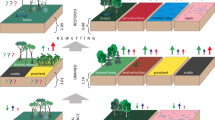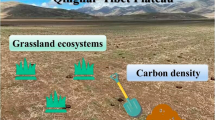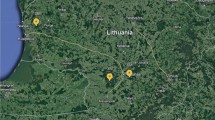Abstract
Quantification of annual carbon sequestration is very important in order to assess the function of forest ecosystems in combatting global climate change and the ecosystem responses to those changes. Annual cycling and budget of carbon in a forested basin was investigated to quantify the carbon sequestration of a cool-temperate deciduous forest ecosystem in the Horonai stream basin, Tomakomai Experimental Forest, northern Japan. Net ecosystem exchange, soil respiration, biomass increment, litterfall, soil-solution chemistry, and stream export were observed in the basin from 1999–2001 as a part of IGBP-TEMA project. We found that 258 g C m−2 year−1 was sequestered annually as net ecosystem exchange (NEE) in the forested basin. Discharge of carbon to the stream was 4 g C m−2 year−1 (about 2% of NEE) and consisted mainly of dissolved inorganic carbon (DIC). About 43% of net ecosystem productivity (NEP) was retained in the vegetation, while about 57% of NEP was sequestered in soil, suggesting that the movement of sequestered carbon from aboveground to belowground vegetation was an important process for net carbon accumulation in soil. The derived organic carbon from aboveground vegetation that moved to the soil mainly accumulated in the solid phase of the soil, with the result that the export of dissolved organic carbon to the stream was smaller than that of dissolved inorganic carbon. Our results indicated that the aboveground and belowground interaction of carbon fluxes was an important process for determining the rate and retention time of the carbon sequestration in a cool-temperate deciduous forest ecosystem in the southwestern part of Hokkaido, northern Japan.






Similar content being viewed by others
References
Baldocchi D, Falge E, Gu L, Olson R, Hollinger D, Running S, Anthoni P, Bernhofer C, Davis K, Evans R, Fuentes J, Goldstein A, Katul G, Law B, Lee X, Malhi Y, Meyers T, Munger W, Oechel W, Paw KT, Pilegaard K, Schmid HP, Valentini R, Verma S, Vesala T, Wilson K, Wofsy S (2001) FLUXNET: a new tool to study the temporal and spatial variability of ecosystem-scale carbon dioxide, water vapor, and energy flux densities. Bull Am Meteorol Soc 82:2415–2434
Chapin FS III, Matson PA, Mooney HA (2002) Principles of terrestrial ecosystem ecology. Springer, New York
Cole DW, Rapp M (1981) Elemental cycling in forest ecosystem. In: Reichle ED (ed) Dynamic properties of forest ecosystems. Cambridge University Press, Cambridge, pp 341–410
Eguchi S, Sakata T, Hatano R, Sakuma, T (1997) Daily change of CO2 efflux from the soil of a deciduous broad-leaved forest and its significance as a CO2 source for vegetation (in Japanese with English summary). Jpn J Soil Sci Plant Nutr 68:138–147
Hiura T (2001) Stochasticity of species assemblage of canopy trees and understory plants in a temperate secondary forest created by major disturbances. Ecol Res 16:887–893
Hiura T (2005) Above-ground biomass and net biomass increment in a cool temperate forest on a landscape scale (this issue). Ecol Res 20
Lloyd J (1999) The CO2 dependence of photosynthesis, plant growth responses to elevated CO2 concentrations and their interaction with soil nutrient status. II Temperate and boreal forest productivity and the combined effects of increasing CO2 concentrations and increased nitrogen deposition at a global scale. Funct Ecol 13:439–759
Malhi Y, Baldocchi DD, Jarvis PG (1999) The carbon balance of tropical, temperate and boreal forests. Plant Cell Env 22:715–740
Nadelhoffer KJ, Emmett BA, Gundersen P, Kjonaas OJ, Koopmans CJ, Schleppi P, Tietema A, Wright RF (1999) Nitrogen deposition makes a minor contribution to carbon sequestration in temperate forests. Nature 398:145–148
Raich JW, Schlesinger WH (1992) The global carbon dioxide flux in soil respiration and its relationship to vegetation and climate. Tellus B 44:81–99
Reich PB, Bolstad P (2001) Productivity of evergreen and deciduous temperate forest. In: Roy J, Saugier B, Mooney HA (eds) Terrestrial global productivity. Academic Press, San Diego, pp 245–284
Sakuma T (1987) Characterization of soils in the tomakomai experiment forest (in Japanese with English summary). Res Bull Coll Exp For Hokkaido Univ 44:749–759
Satomura T, Nakatsubo T, Horikoshi T (2003) Estimation of the biomass of fine roots and mycorrhizal fungi: a case study in a Japanese red pine (Pinus densiflora) stand. J For Res 8:221–225
Shibata H, Kirikae M, Tanaka Y, Sakuma T, Hatano R (1998) Proton budgets of forest ecosystems on volcanogenous Regosols in Hokkaido, northern Japan. Water Air Soil Pollut 105:63–72
Shibata H, Mitsuhashi H, Miyake Y, Nakano S (2001) Dissolved and particulate carbon dynamics in a cool-temperate forested basin in northern Japan. Hydrol Process 15:1817–1828
Shutou K, Nakane K (2004) Change in soil carbon cycling for stand development of Japanese cedar (Cryptomeria japonica) plantations following clear-cutting. Ecol Res 19:233–244
Soil Survey Staff (1994) Keys to soil taxonomy. USDA Conservation Service, Washington
Takahashi K, Yoshida K, Suzuki M, Seino T, Tani T, Tashiro N, Ishii T, Sugata S, Fujito E, Naniwa A, Kudo G, Hiura T, Kohyama T (1999) Stand biomass, net production and canopy structure in a secondary deciduous broad-leaved forest, northern Japan. Res Bull Hokkaido Univ For 56:70–85
Tanaka Y, Tanaka N, Hatano R (2001) Seasonal variation of carbon dioxide and energy fluxes above a cool, temperate, broad-leaved forest. CGER-Report M-011-2001. In: Proceedings of international workshop for advanced flux network and flux evaluation, Sapporo, Japan, pp 133–137
Yamamoto S, Murayama S, Saigusa N, Kondo H (1999) Seasonal and inter-annual variation of CO2 flux between a temperate forest and atmosphere in Japan. Tellus 51B:402–413
Yanagihara Y, Koike T, Matsuura Y, Mori S, Shibata H, Satoh F, Masuyagina OV, Zyryanova OA, Prokushkin AS, Prokushkin SG, Abaimov AP (2000) Soil respiration rate on the contrasting north- and south-facing slopes of a larch forest in central Siberia. Eurasian J For Res 1:19–29
Acknowledgements
We would like to thank Ms. Yuko Yanagihara and all of the technical staff of the Tomakomai Research Station, Hokkaido University for their helpful fieldwork and maintenance of the observation instruments. We express our considerable thanks to Prof. Kenkichi Ishigaki and the late Prof. Shigeru Nakano for their constructive advice and their great efforts toward this research program. This study was funded by the Japanese Ministry of Education, Science, Sports, Culture and Technology (B(1)-11213101).
Author information
Authors and Affiliations
Corresponding author
About this article
Cite this article
Shibata, H., Hiura, T., Tanaka, Y. et al. Carbon cycling and budget in a forested basin of southwestern Hokkaido, northern Japan. Ecol Res 20, 325–331 (2005). https://doi.org/10.1007/s11284-005-0048-7
Received:
Accepted:
Published:
Issue Date:
DOI: https://doi.org/10.1007/s11284-005-0048-7




